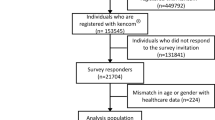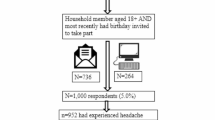Abstract
Background: Headache impact test (HIT™) is a precise, practical tool that quantifies the impact of headache on respondents' lives. It is the first widely-available dynamic health assessment (DynHA™). Applications of this brief, precise survey include population based screening for disabling headaches, tracking of individual patient scores over time, disease management programs and others. We use data from Internet HIT assessments during the fall of 2000 to (1) evaluate characteristics of respondents and assessments, (2) assess the utility of joint administration of HIT and the SF-8™ Health Survey (SF-8™) to screen for migraine and depression, and (3) explore associations between HIT scores and subsequent healthcare-related attitudes and behaviors. Methods: We analyzed Internet HIT surveys completed between 9/1 and 11/30/2000 (n = 19,195). Subsamples include respondents who also completed (1) a 12-item Internet survey assessing severity, frequency, cause and management of headaches; (2) an e-mail survey measuring healthcare-related behaviors; (3) the SF-8; or (4) the website registration process, providing age and gender data. We used analysis of variance (ANOVA) to evaluate HIT score differences associated with age, gender, headache severity or frequency, and healthcare-related behaviors and attitudes and χ2 tests to assess the prevalence and comorbidity of migraine and depression. Results: Three-quarters of respondents achieved a precise HIT score in ≤5 items. Most had moderate/severe headaches; 65% had headaches at least monthly. HIT scores were directly related to headache severity and frequency. Most respondents were females, with significantly higher HIT scores than males. Most HIT respondents were between ages 25 and 54 (HIT scores were higher for younger respondents). Sixty four percent screened positive for migraine; 20% for depression. Both conditions were more prevalent among females than males. Comorbid migraine and depression was 50% more prevalent among females and increased with age until age 50. Patients with worse headache impact were more likely to seek care, discuss headaches with their providers and find HIT useful. Conclusions: It is feasible to use Internet-based dynamic assessments to measure health status. These data complement previous results showing that HIT differentiates respondents according to headache characteristics (severity and frequency). HIT plus SF-8 yields a practical screen for migraine and depression in headache patients and may lead to more effective treatment for patients with these conditions. Preliminary findings suggest that the experience of taking HIT on the Internet may motivate headache patients to seek care and discuss headaches with their providers.
Similar content being viewed by others
References
Bjorner JB, Kosinski M, Ware JE. Calibration of an item pool for assessing the burden of headaches: An application of item response theory to the Headache Impact Test (HITTM) Quality Life Res 2003; 12: 913–933.
Ware JE, Kosinski M, Bjorner JB, et al. Applications of computerized adaptive testing (CAT ) to the assessment of headache impact. Quality Life Res 2003; 12: 935–952.
Ware JE Jr, Bjorner JB, Kosinski M. Practical implications of item response theory and computerized adaptive testing: A brief summary of ongoing studies of widely used headache impact scales. Med Care 2000; 38(Suppl 9): II73–II82.
Wainer H, Dorans NJ, Flaugher R, et al. Computerized Adaptive Testing: A Primer. 2nd ed. Hillsdale, NJ: Lawrence Erlbaum Associates, 2000.
Lipton RB, Hamelsky SW, Kolodner KB, et al. Migraine, quality of life, and depression: A population-based case-control study. Neurology 2000; 55(5): 610–611.
Silberstein S, Lipton R, Breslau N. Migraine: Association with personality characteristics and psychopathology. Cephalalgia 1995; 15: 358–369.
Merikangas K, Angst J, Isler H. Migraine and psychopathology: Results of the Zurich cohort study of young adults. Arch Gen Psychiat 1990; 47: 849–853.
Breslau N, Davis F. Migraine, major depression and panic disorder: A prospective epidemiologic study of young adults. Cephalalgia 1992; 12: 85–90.
Breslau N, Davis G, Schultz L, Peterson F. Joint 1994 Wolff Award Presentation. Migraine and major depression: A longitudinal study. Headache 1994; 34: 387–393.
Breslau N, Schultz L, Stewart W, et al. Headache and major depression: Is the association specific to migraine? Neurology 2000; 54: 308–313.
Ware JE, Kosinski M, Dewey JE, Gandek B. How to Score and Interpret Single-Item Health Status Measures: A Manual for Users of the SF-8TM Health Survey. Lincoln, RI: QualityMetric Incorporated, 2001.
Ware JE, Kosinski M, Dewey J. How to Score Version 2 of SF-36® Health Survey. Lincoln, RI: QualityMetric Incorporated, 2000.
Ware JE, Kosinski M. SF-36 Physical and Mental Health Summary Scales: A Manual for Users of Version. 2nd ed. Lincoln, RI: QualityMetric Incorporated, 2001.
Kosinski M, Cady R, Sheftell F, et al. Use of the Headache Impact Test (HITTM) with other Health Status Assessments to Identify Patients with Comorbid Depression. Presented at the 10th Congress of the International Headache Society, New York, 29 June-2 July, 2001.
International Headache Society. Classification and diagnostic criteria for headache disorders, cranial neuralgias and facial pain. Headache Classification Committee of the International Headache Society. Cephalalgia 1988; 8(Suppl 7): 1–96.
Berwick DM, Murphy JM, Goldman PA, et al. Performance of a five-item mental health screening test. Med Care 1991; 29(2): 169–176.
Weinstein MC, Berwick DM, Goldman PA, et al. A comparison of three psychiatric screening tests using receiver operating characteristic (ROC) analysis. Med Care 1989; 27(6): 593–607.
Sheehan K. E-mail survey response rates: A review. J Comput Mediated Commun 2001; 6(2) [online].
Author information
Authors and Affiliations
Rights and permissions
About this article
Cite this article
Bayliss, M., Dewey, J., Dunlap, I. et al. A study of the feasibility of Internet administration of a computerized health survey: The headache impact test (HIT™). Qual Life Res 12, 953–961 (2003). https://doi.org/10.1023/A:1026167214355
Issue Date:
DOI: https://doi.org/10.1023/A:1026167214355




